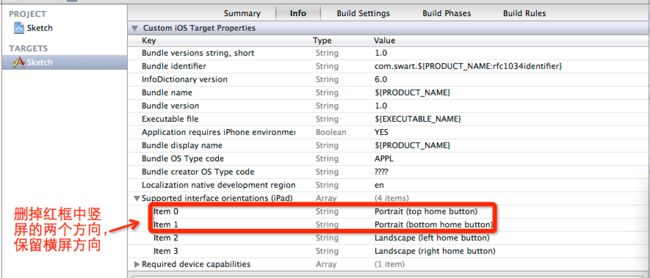在一般的视频类APP播放的时候都会支持横屏,这样做的好处就是便于观看。你的项目中支持横屏吗?我们一起了解一下,在iOS9中横竖屏设置的处理方法吧!
支持横竖屏配置
第一种:
在iOS6以后,如果APP需要支持横屏,需要在xcode设置中General里面进行勾选配置:
配置完成之后,我们可以看一下Info.plist里面的Supported interface orientations选项也相应的改变了。如下图:
当然,我们也可以直接在Info.plist进行配置。
支持横竖屏方法
在iOS6之前我们可以直接用这个方法进行配置:
- (BOOL)shouldAutorotateToInterfaceOrientation:(UIInterfaceOrientation)toInterfaceOrientation NS_DEPRECATED_IOS(2_0, 6_0) __TVOS_PROHIBITED;
在iOS6之后,这个方法被NS_DEPRECATED_IOS,也就是废弃掉了。废弃了这个方法,苹果相应的也给出了新的方法来代替:
// New Autorotation support.
- (BOOL)shouldAutorotate NS_AVAILABLE_IOS(6_0) __TVOS_PROHIBITED;
- (UIInterfaceOrientationMask)supportedInterfaceOrientations NS_AVAILABLE_IOS(6_0) __TVOS_PROHIBITED;
我们可以看到iOS6之前是一个方法,在iOS6之后变成两个方法了,一个是是否旋转的方法,一个是支持的方向的方法。
实例一:
假设:我们ViewController是直接加载window的self.window.rootViewController上面的。代码如下:
- (BOOL)application:(UIApplication *)application didFinishLaunchingWithOptions:(NSDictionary *)launchOptions {
// Override point for customization after application launch.
self.window = [[UIWindow alloc] initWithFrame:[[UIScreen mainScreen] bounds]];
ViewController *vc = [[ViewController alloc] init];
self.window.rootViewController = vc;
[self.window makeKeyAndVisible];
return YES;
}
如果我们要是想支持上面General里勾选的方向(竖屏、横屏向左已经横屏向右)该如何实现呢?首先,我们应该设置让他支持旋转,然后在设置支持的方向。代码如下:
//支持旋转
-(BOOL)shouldAutorotate{
return YES;
}
//支持的方向
- (UIInterfaceOrientationMask)supportedInterfaceOrientations {
return UIInterfaceOrientationMaskAllButUpsideDown;
}
其中UIInterfaceOrientationMask是一个枚举:
typedef NS_OPTIONS(NSUInteger, UIInterfaceOrientationMask) {
UIInterfaceOrientationMaskPortrait = (1 << UIInterfaceOrientationPortrait),
UIInterfaceOrientationMaskLandscapeLeft = (1 << UIInterfaceOrientationLandscapeLeft),
UIInterfaceOrientationMaskLandscapeRight = (1 << UIInterfaceOrientationLandscapeRight),
UIInterfaceOrientationMaskPortraitUpsideDown = (1 << UIInterfaceOrientationPortraitUpsideDown),
UIInterfaceOrientationMaskLandscape = (UIInterfaceOrientationMaskLandscapeLeft | UIInterfaceOrientationMaskLandscapeRight),
UIInterfaceOrientationMaskAll = (UIInterfaceOrientationMaskPortrait | UIInterfaceOrientationMaskLandscapeLeft | UIInterfaceOrientationMaskLandscapeRight | UIInterfaceOrientationMaskPortraitUpsideDown),
UIInterfaceOrientationMaskAllButUpsideDown = (UIInterfaceOrientationMaskPortrait | UIInterfaceOrientationMaskLandscapeLeft | UIInterfaceOrientationMaskLandscapeRight),
} __TVOS_PROHIBITED;
可以根据自己的需求来选择。上面我们说了假设这个条件,如果rootViewController上导航,我们直接在ViewController里面设置,这个方法就不灵了。(大家可以自己测试一下)
实例二:
为什么是导航上面的方法就不灵了呢?原因很简单,我们没有设置导航支持的方向。别忘了UINavigationController也是UIViewController的子类。需要受到同样的待遇的。
如何设置呢?我们可以创建一个UINavigationController的子类,假设叫 GGPublicNavigationViewController。然后,我们在 GGPublicNavigationViewController.m文件里面也实现着两个方法:
//支持旋转
-(BOOL)shouldAutorotate{
return YES;
}
//支持的方向
- (UIInterfaceOrientationMask)supportedInterfaceOrientations {
return UIInterfaceOrientationMaskAllButUpsideDown;
}
这样设置之后,即使我们push进去的UIViewController没有实现上面的连个方法,也是可以支持横屏的。也就是说,我们push的所有都支持横屏。这个做法是不是很暴力!
实例三:
有些童鞋会问了,如何控制每个界面支持的方向呢?这也是可以办到的,在GGPublicNavigationViewController不能写死支持哪个。我们可以这么写:
-(BOOL)shouldAutorotate{
return [self.topViewController shouldAutorotate];
}
//支持的方向
- (UIInterfaceOrientationMask)supportedInterfaceOrientations {
return [self.topViewController supportedInterfaceOrientations];;
}
self.topViewController是当前导航显示的UIViewController,这样就可以控制每个UIViewController所支持的方向啦!
好啦,关于iOS9中横竖屏的处理就说这么多吧!(其实iOS7、iOS8也是这么设置的)如果你觉得文章还不错,分享一下
第二种:通过人为的办法改变view.transform的属性。
具体办法:
view.transform一般是View的旋转,拉伸移动等属性,类似view.layer.transform,区别在于 View.transform是二维的,也就是使用仿射的办法通常就是带有前缀CGAffineTransform的类(可以到API文档里面搜索这个前 缀的所有类),而view.layer.transform可以在3D模式下面的变化,通常使用的都是前缀为CATransform3D的类。
这里要记住一点,当你改变过一个view.transform属性或者view.layer.transform的时候需要恢复默认状态的话,记得 先把他们重置可以使用view.transform = CGAffineTransformIdentity,或者view.layer.transform = CATransform3DIdentity,假设你一直不断的改变一个view.transform的属性,而每次改变之前没有重置的话,你会发现后来 的改变和你想要的发生变化了,不是你真正想要的结果。
好了,上面介绍了旋转的属性,接下来就是关键了。官方提供了一个办法就是查看当前电池条的状态UIInterfaceOrientation orientation = [UIApplication sharedApplication].statusBarOrientation;通过这个办法,你可以知道当前屏幕的电池条的显示方向,而且你还可以 强制设置他的显示方向,通过设置这个属性就OK了,可以选择是否动画改变电池条方向。有了这两个那我们就可以任意的改变我们想要的显示方式了。
1.获取当前电池条的方向UIInterfaceOrientation orientation = [UIApplication sharedApplication].statusBarOrientation
2.获取当前屏幕的大小CGRect frame = [UIScreen mainScreen].applicationFrame;
3.设置我们的View的中心点
CGPoint center = CGPointMake(frame.origin.x + ceil(frame.size.width/2), frame.origin.y + ceil(frame.size.height/2));
4.根据当前电池条的方向,获取需要旋转的角度的大小。通常
if (orientation == UIInterfaceOrientationLandscapeLeft) {
return CGAffineTransformMakeRotation(M_PI*1.5);
} else if (orientation == UIInterfaceOrientationLandscapeRight) {
return CGAffineTransformMakeRotation(M_PI/2);
} else if (orientation == UIInterfaceOrientationPortraitUpsideDown) {
return CGAffineTransformMakeRotation(-M_PI);
} else {
return CGAffineTransformIdentity;
}
5.可以动画的改变我们view的显示方式了
[[UIApplication sharedApplication] setStatusBarOrientation:UIDeviceOrientationLandscapeRight animated:YES];
CGFloat duration = [UIApplication sharedApplication].statusBarOrientationAnimationDuration;(获取当前电池条动画改变的时间)
[UIView beginAnimations:nil context:nil];
[UIView setAnimationDuration:duration];
//在这里设置view.transform需要匹配的旋转角度的大小就可以了。
[UIView commitAnimations];
设置横竖屏:进入app和从后台进入前台时
在AppDelegate中进行设置
- (UIInterfaceOrientationMask)application:(UIApplication*)application supportedInterfaceOrientationsForWindow:(UIWindow*)window
{
if(self.isEable) {
returnUIInterfaceOrientationMaskLandscape;
}else{
returnUIInterfaceOrientationMaskPortrait;
}
}
